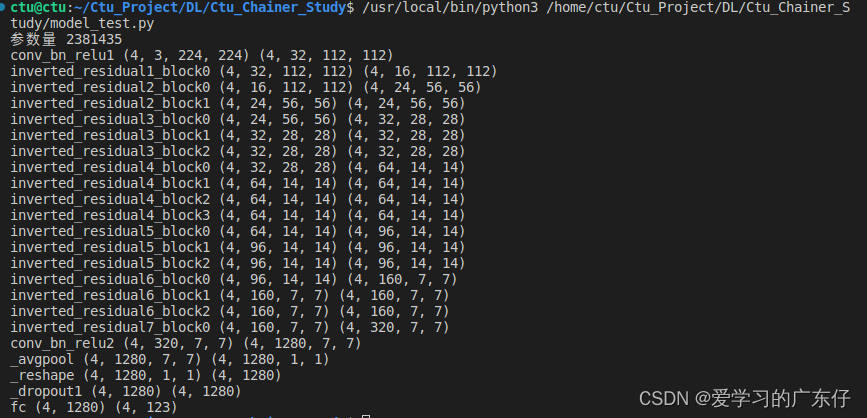前言
本文基于chainer实现MobileNetV2网络结构,并基于torch的结构方式构建chainer版的,并计算MobileNetV2的参数量。
代码实现
class ConvBNReLU(chainer.Chain):
def __init__(self, in_channel, out_channel, kernel_size=3, stride=1, groups=1):
super(ConvBNReLU, self).__init__()
padding = (kernel_size - 1) // 2
self.layers = []
self.layers += [('conv',L.Convolution2D(in_channels=in_channel,out_channels=out_channel,ksize=kernel_size,stride=stride,pad=padding,groups=groups,nobias=True))]
self.layers += [('bn',L.BatchNormalization(out_channel))]
self.layers += [('_relu6',ClippedReLU(6.0))]
with self.init_scope():
for n in self.layers:
if not n[0].startswith('_'):
setattr(self, n[0], n[1])
def __call__(self, x):
for n, f in self.layers:
if not n.startswith('_'):
x = getattr(self, n)(x)
else:
x = f.apply((x,))[0]
return x
# 倒残差结构
class InvertedResidual(chainer.Chain):
def __init__(self, in_channel, out_channel, stride, expand_ratio):
super(InvertedResidual, self).__init__()
hidden_channel = in_channel * expand_ratio
self.use_shortcut = stride == 1 and in_channel == out_channel
self.layers = []
if expand_ratio != 1:
self.layers += [('conv_bn_relu',ConvBNReLU(in_channel, hidden_channel, kernel_size=1))]
self.layers += [('dw_conv',ConvBNReLU(hidden_channel, hidden_channel, stride=stride, groups=hidden_channel))]
self.layers += [('pw_conv',L.Convolution2D(hidden_channel, out_channel, ksize=1, nobias=True))]
self.layers += [('bn',L.BatchNormalization(out_channel))]
with self.init_scope():
for n in self.layers:
if not n[0].startswith('_'):
setattr(self, n[0], n[1])
def __call__(self, x):
shortcut = x
for n, f in self.layers:
if not n.startswith('_'):
x = getattr(self, n)(x)
else:
x = f.apply((x,))[0]
if self.use_shortcut:
return shortcut + x
else:
return x
def _make_divisible(ch, divisor=8, min_ch=None):
if min_ch is None:
min_ch = divisor
new_ch = max(min_ch, int(ch + divisor / 2) // divisor * divisor)
if new_ch < 0.9 * ch:
new_ch += divisor
return new_ch
class MobileNet_V2(chainer.Chain):
cfgs={
'mobilenetv2_1.0':{
'alpha':1.0},
'mobilenetv2_0.75':{
'alpha':0.75},
'mobilenetv2_0.5':{
'alpha':0.5},
'mobilenetv2_0.25':{
'alpha':0.25}
}
def __init__(self, model_name='mobilenetv2_1.0',num_classes=1000,batch_size=4,image_size=224,round_nearest=8,**kwargs):
super(MobileNet_V2, self).__init__()
self.image_size = image_size
block = InvertedResidual
input_channel = _make_divisible(32 * self.cfgs[model_name]['alpha'], round_nearest)
last_channel = _make_divisible(1280 * self.cfgs[model_name]['alpha'], round_nearest)
inverted_residual_setting = [
# t, c, n, s
[1, 16, 1, 1],
[6, 24, 2, 2],
[6, 32, 3, 2],
[6, 64, 4, 2],
[6, 96, 3, 1],
[6, 160, 3, 2],
[6, 320, 1, 1],
]
self.layers = []
# 第一个卷积层,input:224*224*3 output:112*112*32
self.layers += [('conv_bn_relu1',ConvBNReLU(3, input_channel, stride=2))]
output_size = int((self.image_size-3+2*((3 - 1) // 2))/2 +1)
# 定义一系列block结构 input:112*112*32 output: 7*7*320
inverted_residual_num=0
for t, c, n, s in inverted_residual_setting:
inverted_residual_num +=1
output_channel = _make_divisible(c * self.cfgs[model_name]['alpha'], round_nearest)
for i in range(n):
stride = s if i == 0 else 1 # 判断是否是block中的第一层,因为参数s只是表示第一层的stride,其他层都是1
self.layers += [('inverted_residual{0}_block{1}'.format(inverted_residual_num,i),block(input_channel, output_channel, stride, expand_ratio=t))]
input_channel = output_channel
output_size = math.ceil(output_size/stride)
# 定义bottlenet的下边一层 input:7*7*320 output: 7*7*1280
self.layers += [('conv_bn_relu2',ConvBNReLU(input_channel, last_channel, 1))]
output_size = math.ceil((output_size-1+2*((1 - 1) // 2))/1 +1)
# input:7*7*1280 output: 1*1*1280
self.layers += [('_avgpool',AveragePooling2D(ksize=output_size,stride=2,pad=0))]
self.layers += [('_reshape',Reshape((batch_size,last_channel)))]
self.layers += [("_dropout1",Dropout(0.2))]
self.layers += [('fc',L.Linear(last_channel, num_classes))]
with self.init_scope():
for n in self.layers:
if not n[0].startswith('_'):
setattr(self, n[0], n[1])
def __call__(self, x):
for n, f in self.layers:
origin_size = x.shape
if not n.startswith('_'):
x = getattr(self, n)(x)
else:
x = f.apply((x,))[0]
print(n,origin_size,x.shape)
if chainer.config.train:
return x
return F.softmax(x)
注意此类就是MobileNetV2的实现过程,注意网络的前向传播过程中,分了训练以及测试。
训练过程中直接返回x,测试过程中会进入softmax得出概率
调用方式
if __name__ == '__main__':
batch_size = 4
n_channels = 3
image_size = 224
num_classes = 123
model = MobileNet_V2(num_classes=num_classes, channels=n_channels,image_size=image_size,batch_size=batch_size)
print("参数量",model.count_params())
x = np.random.rand(batch_size, n_channels, image_size, image_size).astype(np.float32)
t = np.random.randint(0, num_classes, size=(batch_size,)).astype(np.int32)
with chainer.using_config('train', True):
y1 = model(x)
loss1 = F.softmax_cross_entropy(y1, t)
